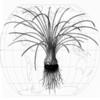| Publication Type: | Journal Article |
| Year of Publication: | 2004 |
| Authors: | S. B. Hoot, Napier, N. S., Taylor, W. C. |
| Journal: | American Journal of Botany |
| Volume: | 91 |
| Issue: | 6 |
| Pagination: | 899 - 904 |
| Date Published: | 2004/// |
| Keywords: | Allopolyploidy, Hybrid origins, Isoetes, LEAFY intron |
| Abstract: | Isoëtes, a heterosporous lycopod with a fossil record dating back to the Paleozoic, has numerous putative allopolyploids (resulting from hybridization events coupled with doubling of chromosome number). By using the highly variable nucleotide sequences from the second intron of a LFY homologue in Isoëtes, species could be delimited and hybrid origins determined. The data suggest that reticulate evolution is both common and complex within a more derived species complex of Isoëtes. Sequences of identifiable parentage and sequences that are unlike any diploid species known were recovered, leading to the conclusion that one or both of the putative parents have not yet been discovered or are extinct. A range of observations concerning allopolyploid speciation were categorized as follows: (1) verification of previous hypotheses regarding parentage (e.g., I. riparia, I. appalachiana), (2) determination that two morphologically distinct allotetraploid species can share the same parentage (I. azorica and I. acadiensis), (3) recognition of a cryptic allotetraploid species, indicated by the presence of different parental genomes (I. "appalachiana" from Florida), and (4) identification of allotetraploid species with one or two unknown parents (e.g., I. tuckermanii, I. acadiensis, I. azorica, and I. hyemalis). Some sequences from diploid species are remarkably uniform among populations (e.g., I. echinospora from various locations in North America, Iceland, and Wales), while others are variable at the subspecies level (e.g., northern and southern populations within I. engelmannii). |
| URL: | http://www.scopus.com/inward/record.url?eid=2-s2.0-11444256350&partnerID=40&md5=420a4ad06820ce82f60d7a70e7db9dec |
Revealing unknown or extinct lineages within Isoëtes (Isoëtaceae) using DNA sequences from hybrids
Taxonomic name:
